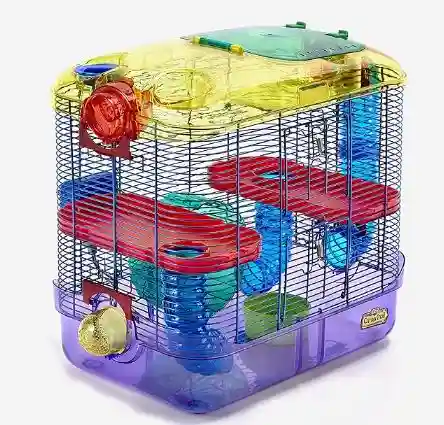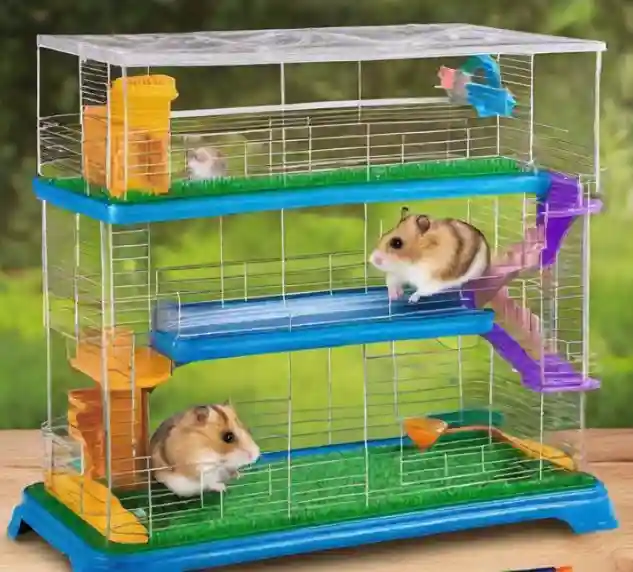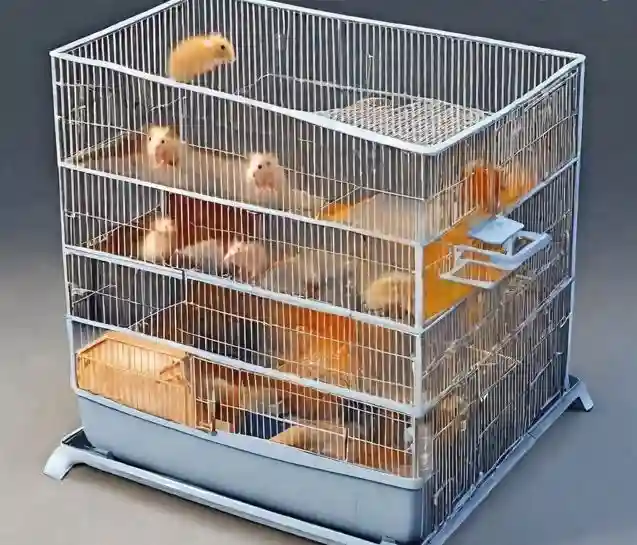When it comes to providing a comfortable and secure home for your beloved dwarf hamster, choosing the right cage is of utmost importance. The right hamster cage can significantly impact your hamster’s well-being, happiness, and overall quality of life. In this comprehensive guide, we’ll walk you through the essential factors to consider, offer expert recommendations, and provide valuable insights to ensure you select the best hamster cage for your furry companion. Let’s dive in!
How to Choose the Best Cages for Dwarf Hamsters

Selecting the perfect cage for your dwarf hamster requires careful consideration of various factors. From size and material to design and accessories, each element plays a vital role in creating a comfortable and stimulating environment for your pet.
- Hamsters Cage Material: Safety and Durability: Choose a hamster cage made from safe and durable materials. Wire cages with narrow bar spacing are a popular choice, as they allow ventilation and easy visibility. However, ensure that the spacing is suitable for dwarf hamsters, preventing them from getting stuck or escaping. Additionally, avoid cages with sharp edges or toxic materials.
- Optimal Hamster Cage Dimensions: One of the most critical aspects to consider is the size of the cage. Dwarf hamsters are active and curious creatures, so providing ample space is essential. Look for hamster cages that offer a minimum of 450 square inches of floor space. This ensures your hamster has enough room to explore, exercise, and create nesting areas.
- Multi-Level Hamster Cage: The Joy of Vertical Space: Dwarf hamsters love to climb and explore, so a multi-level cage can be a fantastic option. This type of cage provides vertical space, allowing your hamster to exercise and satisfy its instincts. Ensure that the levels are accessible with ramps or tubes and that there’s enough headroom on each level.
- Easy Access: Cage Design and Maintenance: Opt for a cage with easy access points. Look for models with large doors, secure latches, and removable trays for straightforward cleaning. A cage with a top-opening feature can be convenient for interaction and maintenance, making it easier to reach your hamster and change bedding.
- Hamster Cage Essential Accessories: Creating a Hamster Haven: A well-equipped hamster cage enhances your hamster’s life. Include essential accessories such as a cozy nesting area, exercise wheel, water bottle, and food dish. Consider adding tunnels, hideouts, and chew toys to keep your hamster mentally and physically stimulated.
Expert Recommendations: Top Best Hamsters Cage Picks
To simplify your search for the best hamster cage, we’ve compiled a list of expert-recommended options that meet the criteria for size, material, and overall hamster happiness:
- Kaytee CritterTrail 2-Level Habitat: This multi-level hamster cage provides ample space for your hamster to explore, with easy access and a secure design.
- Prevue Hendryx Deluxe Hamster and Gerbil Cage: A spacious wire hamster cage with tight bar spacing, offering safety and durability.
- Ferplast HAMSTERVILLE Hamster Habitat Cage: A well-designed cage with a deep base, ideal for burrowing, and a transparent top for visibility.
- Living World Deluxe Habitat: This hamster cage features a balcony level, a hideout, and a water bottle, creating a comfortable and engaging environment.
Choosing the Best Style of Dwarf Hamster Cage: Factors to Consider
When it comes to selecting the perfect cage for your dwarf hamster, the style of the cage is a crucial factor that can significantly impact your pet’s comfort, safety, and overall well-being. Each type of cage has its advantages and disadvantages, so it’s essential to carefully consider the specific needs of your hamster and your preferences. In this article, we’ll explore the different cage styles available, including wire cages, plastic modular cages, and aquariums, and highlight the important aspects to keep in mind for each style.
Wire Cages: A Balance of Ease and Ventilation

Wire cages with a plastic base are a popular choice among hamster owners due to their practicality and ventilation. These cages offer a good balance between ease of cleaning and providing proper airflow for your hamster.
- Ease of Cleaning: The design of wire cages with a removable plastic tray makes them relatively easy to clean. You can lift off the wire part from the bottom, remove the bedding, and wipe down the wire and base as needed. This convenience is essential since regular cage cleaning is essential to maintain your hamster’s health and hygiene.
- Ventilation: Wire cages excel in providing excellent ventilation for your hamster. The openness of the wire structure ensures that fresh air circulates throughout the cage, promoting a healthy environment. However, it’s essential to place the cage away from drafts to prevent your hamster from getting cold.
Plastic Modular Cages: Consider Complexity
Plastic modular cages, characterized by multiple compartments and tubes, offer a more complex habitat for your hamster. While they can be visually appealing and stimulating for your pet, they come with certain considerations.

- Ease of Cleaning: Unfortunately, plastic modular cages can be more challenging to clean compared to wire cages. The various compartments and tubes can accumulate bedding and debris, making cleaning a more time-consuming task. If you opt for this style of cage, be prepared for the extra effort needed for maintenance.
- Ventilation: Ventilation can be a concern with plastic modular cages, especially if they have enclosed compartments and tubes. Ensuring adequate air quality and preventing condensation may require extra attention. If you choose this style, make sure to regularly check for any signs of poor ventilation.
Aquariums: A Unique Option
Using an aquarium as a hamster cage is another option to consider. While it has its advantages, it’s essential to keep in mind the specific characteristics of this style.
- Ease of Cleaning: Cleaning an aquarium is relatively straightforward, but the main challenge lies in handling the weight and size of the tank. You’ll need to remove the bedding, clean the tank, and replace the bedding. The process is manageable but requires some physical effort.
- Ventilation: Aquariums, while easy to clean, may have inadequate ventilation. Unlike wire cages, which offer excellent airflow, aquariums can trap air and moisture. It’s essential to monitor the air quality and ensure proper ventilation by occasionally lifting the lid or using a secure mesh lid.
Size, Security, and More: Common Considerations
No matter which cage style you choose, certain universal factors apply to ensure the safety, comfort, and happiness of your dwarf hamster.
- Size Matters: Dwarf hamsters, despite their small size, require ample space to run, play, and exhibit natural behaviors. Aim for a cage with a minimum of 450 square inches of floor space, as recommended by experts. Providing enough room allows your hamster to explore and stay active.
- Cage Security and Safety: Pay close attention to the space between the bars on wire cages or any potential escape points on plastic modular cages. Ensure that your hamster cannot squeeze through or get stuck in any gaps. Check the cage doors to make sure they are secure, as hamsters are adept at finding ways to open doors.
- Chewing Considerations: Hamsters are natural chewers, and their cages should be designed with this behavior in mind. For plastic cages, ensure there are no exposed edges or ridges that your hamster can start chewing, as this can lead to escapes. Wire cages generally prevent chewing escapes, but some hamsters may chew the bars extensively. Aquariums are less likely to have chewable parts.
- Suitable Wheels: Hamsters need a suitable wheel for exercise, and it should be large enough to prevent them from arching their backs while running. Choose a wheel with a solid surface and no crossbars for support to prevent injuries. Run-about balls can also be a good option for outside playtime.
- Adequate Bedding: Regardless of the cage style, provide a deep layer of bedding for burrowing, which is essential for your hamster’s natural behavior. A cage with a deep tray helps reduce the amount of bedding kicked out.
Conclusion: Choose Wisely for Your Hamster’s Happiness
Choosing the best style of dwarf hamster cage involves balancing factors such as ease of cleaning, ventilation, size, security, and suitability for your hamster’s behaviors. It’s essential to carefully evaluate each aspect and select a cage that aligns with your hamster’s needs and your preferences. Remember, a happy hamster in a comfortable environment is a joy to care for.
Frequently Asked Questions (FAQs)
Can I use an aquarium for my hamster if I provide proper ventilation?
While aquariums can be used, ensuring adequate ventilation is crucial. Regularly monitor air quality and use a secure mesh lid to promote airflow.
Do I need to provide bedding in the cage?
Yes, bedding is essential for creating a comfortable and safe environment for your hamster. Choose hamster-safe bedding material, such as aspen shavings or paper-based bedding.
How often should I clean the hamster cage?
Regular cleaning is crucial to keep your hamster healthy. Spot-clean the cage daily, and perform a thorough cleaning at least once a week, changing the bedding and cleaning all accessories.
Can I keep multiple dwarf hamsters in the same cage?
Dwarf hamsters are typically solitary animals and may not get along well with cage mates. It’s best to keep them in separate cages to prevent aggression.
What should I look for in a hamster wheel?
Choose a solid-surface, appropriately sized wheel to prevent injuries. Avoid wire or mesh wheels, as they can cause harm to your hamster’s feet.
How do I introduce new accessories to my hamster’s cage?
Introduce new accessories gradually, allowing your hamster to get used to them. Observe your hamster’s behavior to ensure they are comfortable and safe.
Can I use an aquarium for my hamster if I provide proper ventilation?
While aquariums can be used, ensuring adequate ventilation is crucial. Regularly monitor air quality and use a secure mesh lid to promote airflow.
Are plastic modular cages suitable for dwarf hamsters?
Plastic modular cages can be stimulating but may be more challenging to clean and monitor for ventilation. Consider your willingness to invest extra effort in maintenance.
Should I choose a larger cage even if my hamster is small?
Yes, providing ample space is essential. A minimum of 450 square inches of floor space allows your hamster to stay active and exhibit natural behaviors.
What’s the best type of wheel for my hamster?
Choose a wheel that is large enough, has a solid surface, and no crossbars for support. Run-about balls can also be a good option for outside play.
How deep should the bedding be in the cage?
Provide a nice, deep layer of bedding for burrowing. A cage with a deep tray helps reduce the amount of bedding your hamster pushes out.
Can I use a plastic cage with exposed edges for my hamster?
It’s best to avoid cages with exposed edges, as hamsters may chew on them and attempt to escape. Ensure the cage is hamster-safe.
Do hamsters like 2 level cages?
Dwarf hamsters, like their larger counterparts, can enjoy two-level cages if the design is appropriate and if there is ample space for them to move comfortably between levels. However, it’s essential to consider the size and layout of the two-level cage to ensure it meets the hamster’s needs and preferences.
What is the minimum size enclosure for a dwarf hamster?
When it comes to the minimum size enclosure for a dwarf hamster, it’s recommended to aim for at least 450 square inches of floor space. This measurement is a guideline provided by experts, such as the California Hamster Association. Providing adequate space ensures that your dwarf hamster has room to explore, exercise, and express natural behaviors.







Leave a Comment
You must be logged in to post a comment.